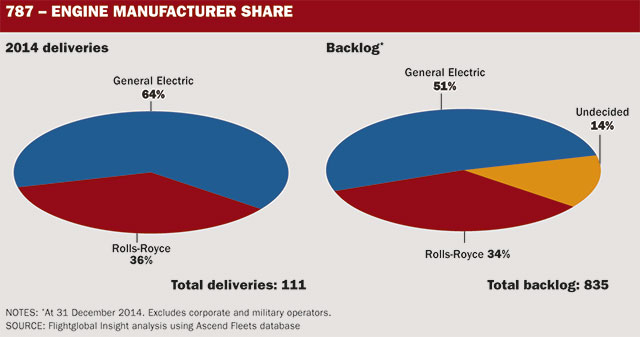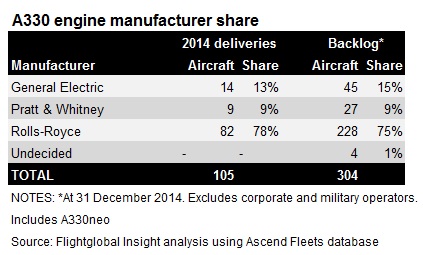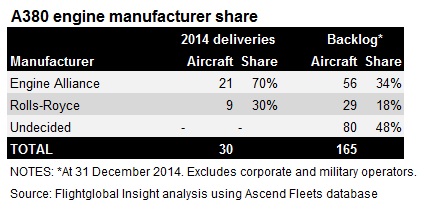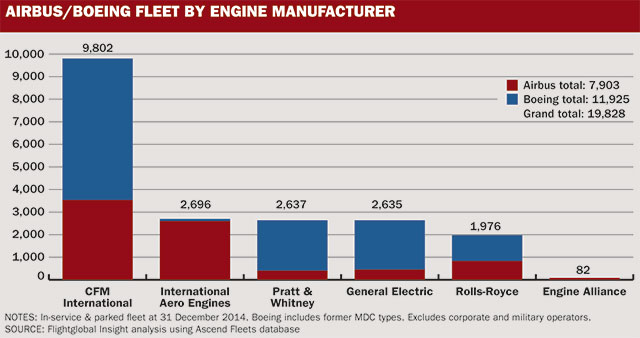Powerplants are central to key airframe developments in the air transport sector as the tempo rises around the re-engined narrowbody sector – and the battle is raging as the manufacturers fight for market share.
Our annual analysis of market trends using Flightglobal's Ascend Fleets database highlights how CFM International still wears the crown as the industry's leading supplier. But the renaissance at Pratt & Whitney continues as it rebuilds its market share in the single-aisle sector through its successful geared turbofan, the PW1000G. The engine is an option on the Airbus A320neo, and the only powerplant on the Bombardier CSeries, Mitsubishi MRJ and Embraer E-Jet E2.

In 2014, Airbus and Boeing between them produced a record 1,324 commercial airliners, up 6% on the year before. This resulted in 2,746 installed engines being shipped by CFM, P&W, Rolls-Royce, International Aero Engines and Engine Alliance. The powerplant order backlog (based on installed units) at the end of last year stood at 24,650 engines.
CFM accounted for just over half of all the installed engines delivered to commercial operators on mainline airliners during 2014, with a total of 1,412 units. It has a similar share of the backlog, with its total standing at almost 12,200 units, which represents 49% of all outstanding orders.

CFM's strong performance in shipments is driven by its exclusive supply deal on the Boeing 737, and the fact that it just beat rival IAE, on the A320 family. The single-aisle sector is where the big battle is playing out, as the PW1000G slugs it out with CFM's new Leap engine on the A320 family. But again CFM is exclusive on the 737.
P&W holds 20% of the A320-family sector, and combined with the 10% share held by IAE (in which P&W has a 49.5% stake) its share grows to 30%. CFM is still ahead, on 35%, although there is a similar amount still to play for.

The other key market in the engine competition stakes is around the Boeing 787. Here, CFM's 50% shareholder GE competes with Rolls-Royce and holds the advantage. Its GEnx turbofan powered 64% of the 111 787s delivered to airlines in 2014, and the engine has captured slightly more than half the backlog. Rolls-Royce has around a third of the outstanding orders, with 14% of the backlog still up for grabs.

Rolls-Royce is in a much stronger position on the Airbus A330, where it was already winning the three-way fight with GE and P&W before securing an exclusive supply deal on the A330neo last year. In 2014, Rolls-Royce Trents powered 78% of the A330s delivered, and the UK company holds a 75% share of the backlog.

Engine Alliance is ahead of Rolls-Royce on the A380 – largely thanks to its success with the biggest customer Emirates. The GP7200 powered 70% of the A380s delivered last year and has been selected to power 34% of the backlog. Almost half the 165 A380s on backlog are still subject to an engine choice, but the bulk of these orders are for Emirates, where a selection awaits the outcome of the Airbus’s decision whether to launch a re-engined version.
Unsurprisingly, CFM's market domination extends to the current mainline airliner fleet, where its engines power half of the 19,800 Airbus and Boeings in service (or in temporary storage) with airlines. Boeing 737s account for two-thirds of the CFM fleet.

IAE, P&W and GE all power a similar number of aircraft, with each fleet in the 2,600-2,700 units band. Rolls-Royce is next, powering just under 2,000 aircraft.
In the regional sector, GE is the lead supplier thanks to its prime position on the Bombardier CRJ and Embraer E-Jet. The US manufacturer powered 52% of the 276 regional airliner deliveries last year.
P&W has always had a strong presence in the sector through the turboprop engines produced by its Canadian arm, and powered 38% of the deliveries last year. However, the success of P&W's GTF on the new-generation regional types has propelled it into lead in terms of backlog. The PW1000G powered types account for 63% of the 1,534 regional aircraft on backlog.

Source: Airline Business
















